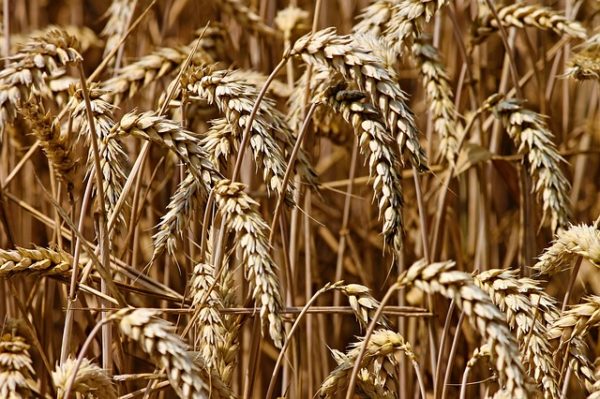


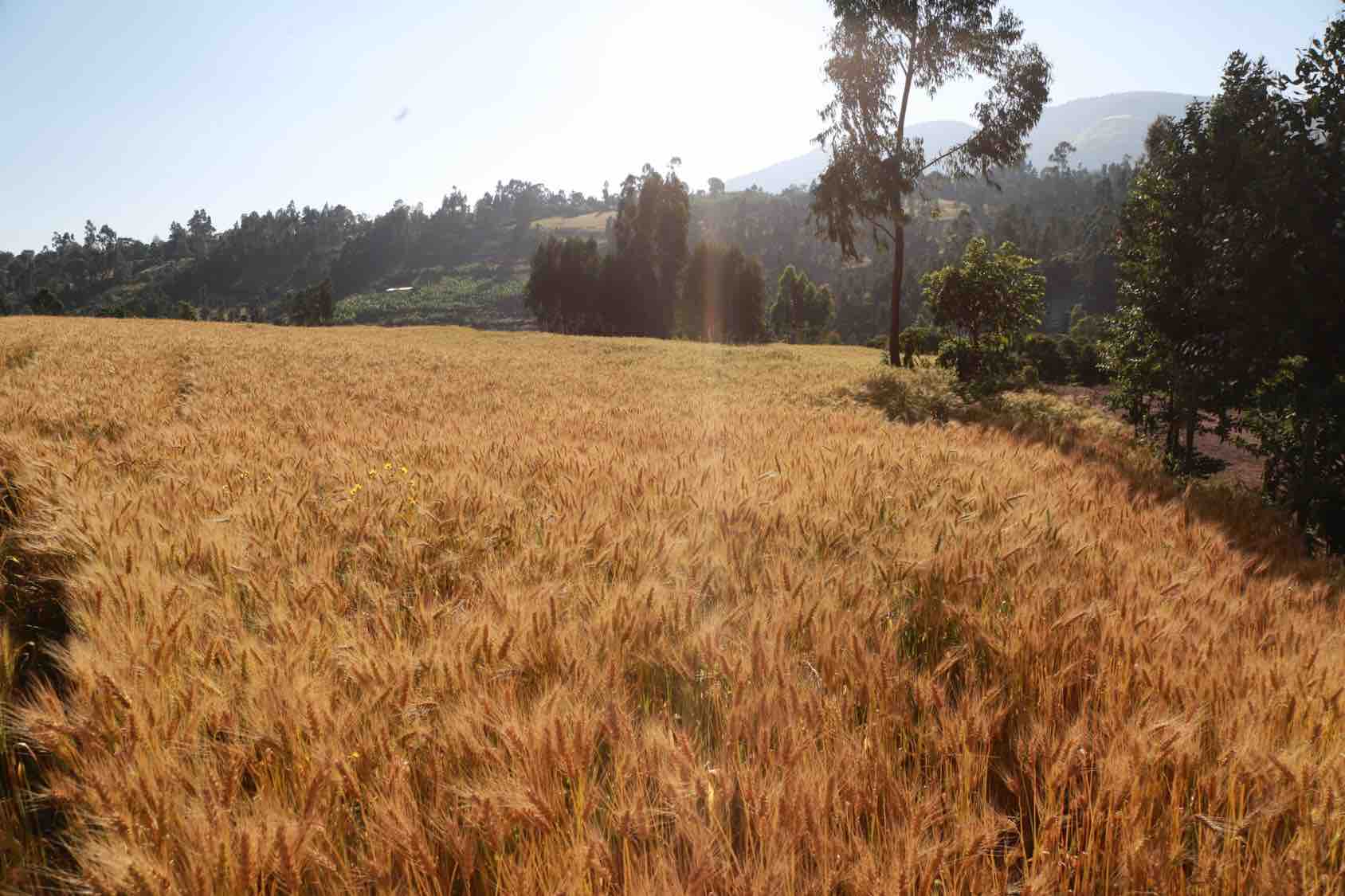
Scientists identified significant new chromosomal regions for wheat yield and disease resistance, which will speed up global breeding efforts.
Using the full wheat genome map published in 2018, combined with data from field testing of wheat breeding lines in multiple countries, an international team of scientists has identified significant new chromosomal regions for wheat yield and disease resistance and created a freely-available collection of genetic information and markers for more than 40,000 wheat lines.
Reported in Nature Genetics, the results will speed up global efforts to breed more productive and climate-resilient varieties of bread wheat, a critical crop for world food security that is under threat from rising temperatures, rapidly-evolving fungal pathogens, and more frequent droughts, according to Philomin Juliana, wheat scientist at the International Maize and Wheat Improvement Center (CIMMYT) and first author of the new study.
“This work directly connects the wheat genome reference map with wheat lines and extensive field data from CIMMYT’s global wheat breeding network,” said Juliana. “That network in turn links to over 200 breeding programs and research centers worldwide and contributes to yield and other key traits in varieties sown on nearly half the world’s wheat lands.”
The staple food for more than 2.5 billion people, wheat provides 20% of human dietary calories and protein worldwide and is critical for the nutrition and food security of hundreds of millions of poor persons in regions such as North Africa and South Asia.
“Farmers and societies today face new challenges to feed rising and rapidly-urbanizing populations, and wheat epitomizes the issues,” said Ravi Singh, CIMMYT wheat breeder and corresponding author of the study. “Higher temperatures are holding back yields in major wheat-growing areas, extreme weather events are common, crop diseases are spreading and becoming more virulent, and soil and water are being depleted.”
Juliana said the study results help pave the way to apply genomic selection, an approach that has transformed dairy cow husbandry, for more efficient wheat breeding.
“Molecular markers are getting cheaper to use; meanwhile, it’s very costly to do field testing and selection involving many thousands of wheat plants over successive generations,” Juliana said. “Genome-wide marker-based selection can help breeders to precisely identify good lines in early breeding generations and to test plantlets in greenhouses, thereby complementing and streamlining field testing.”
The new study found that genomic selection could be particularly effective in breeding for wheat end-use quality and for resistance to stem rust disease, whose causal pathogen has been evolving and spreading in the form of highly-virulent new races.
The new study also documents the effectiveness of the global public breeding efforts by CIMMYT and partners, showing that improved wheat varieties from this work have accumulated multiple gene variants that favor higher yields, according to Hans-Joachim Braun, director of CIMMYT’s global wheat program.
“This international collaboration, which is the world’s largest publicly-funded wheat breeding program, benefits farmers worldwide and offers high-quality wheat lines that are released directly to farmers in countries, such as Afghanistan, that are unable to run a full-fledged wheat breeding program,”
Braun explained.
The study results are expected to support future gene discovery, molecular breeding, and gene editing in wheat, Braun said.
Together with more resource-efficient cropping systems, high-yielding and climate-resilient wheat varieties will constitute a key component of the sustainable intensification of food production described in Strategy 3 of the recent EAT-Lancet Commission recommendations to transform the global food system. Large-scale genomics will play a key role in developing these varieties and staying ahead of climate- and disease-related threats to food security.
Read the paper: Nature Genetics
Article source: CIMMYT
Image: Apollo Habtamu/CIMMYT

By Mathew Reynolds, Wheat Physiologist at, CIMMYT
First post of our “Global Collaboration” series
Wheat is the most widely grown crop in the world, currently providing about 20 percent of human calorie consumption. However, demand is predicted to increase by 60 percent within just 30 years, while long-term climate trends threaten to reduce wheat productivity, especially in less developed countries.
For over half a century, the International Wheat Improvement Network (IWIN), coordinated by CIMMYT, has been a global leader in breeding and disseminating improved wheat varieties to combat this problem, with a major focus on the constraints of resource poor farmers.
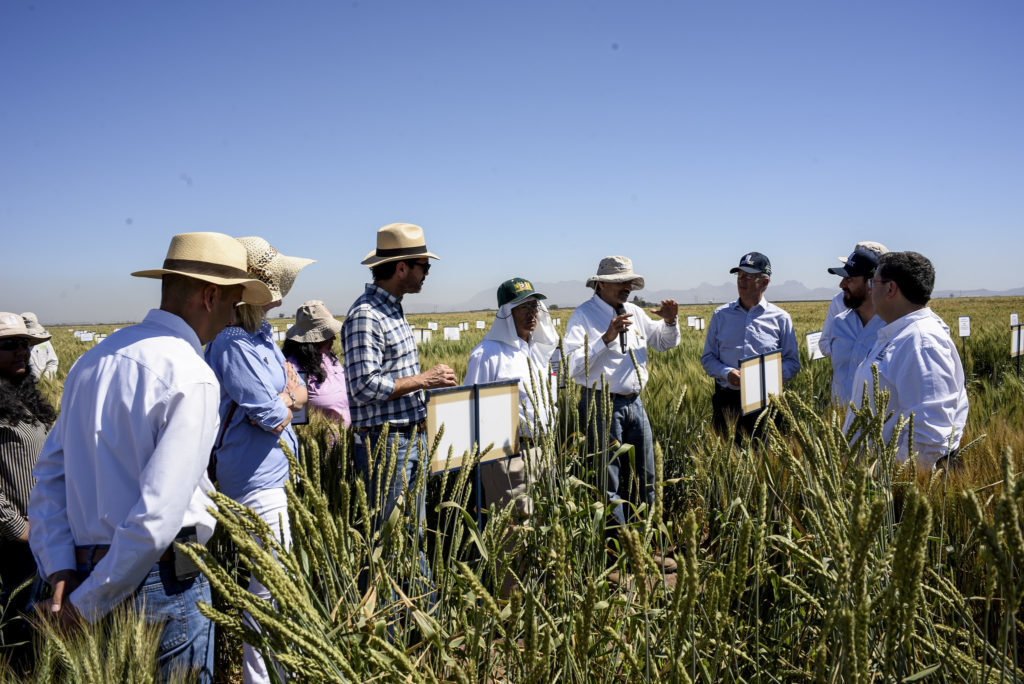
Two complementary networks — the Heat and Drought Wheat Improvement Consortium (HeDWIC) and the International Wheat Yield Partnership (IWYP) — are helping to meet the future demand for wheat consumption through global collaboration and technological partnership.
By harnessing the latest technologies in crop physiology, genetics and breeding, network researchers support the development of new varieties that aim to be more climate resilient, in the case of HeDWIC and with higher yield potential, in the case of IWYP.
These novel approaches to collaboration take wheat research from the theoretical to the practical and incorporate science into real-life breeding scenarios. Methods such as screening genetic resources for physiological traits related to radiation use efficiency and identifying common genetic bases for heat and drought adaptation are leading to more precise breeding strategies and more data for models of genotype-by-environment interaction that help build new plant types and experimental environments for future climates.
IWYP addresses the challenge of raising the genetic wheat yield potential of wheat by up to 50 percent in the next two decades. Achieving this goal requires a strategic and collaborative approach to enable the best scientific teams from across the globe to work together in an integrated program. TheIWYP model of collaboration fosters linkages between ongoing research platforms to develop a cohesive portfolio of activities that maximizes the probability of impact in farmers’ fields IWYP research uses genomic selection to complement the crossing of complex traits by identifying favorable allele combinations among progeny. The resulting products are delivered to national wheat programs worldwide through the IWIN international nursery system.
Recently, IWYP research achieved genetic gains through the strategic crossing of biomass and harvest index — source and sink — an approach that also validates the feasibility of incorporating exotic germplasm into mainstream breeding efforts.
In the case of HeDWIC, intensified — and possibly new — breeding strategies are needed to improve the yield potential of wheat in hotter and drier environments. This also requires a combined effort, using genetic diversity with physiological and molecular breeding and bioinformatic technologies, along with the adoption of improved agronomic practices by farmers. The approach already has proof of concept in the release and adoption of three heat and drought tolerant lines in Pakistan.
It is imperative to build increased yield and climate-resilience to into future germplasm in order to avoid the risk of climate-related crop failure and to maintain global food security in a warmer climate. Partnerships like HeDWIC and IWYP give hope to meeting this urgent food security challenge.
Further readings:
https://www.hedwic.org/resources.htm
https://royalsocietypublishing.org/doi/full/10.1098/rspb.2012.2190
An economist’s perspective on plant sciences: Under-appreciated, over-regulated and under-funded
When I first volunteered to write a blog about the Plant Wax 2015 conference, I thought I’d be writing about its relevance to the Global Plant Council’s stress resilience initiative. After all, the waxy coating (cuticle) that covers the aerial surfaces of plants is particularly important as a barrier against water loss and pathogens, while reflecting excess heat and UV radiation.
As it turns out, one of the most important lessons I learned from the meeting was a reminder of the powerful synergy that can happen when people with radically different goals and approaches get together to share ideas.
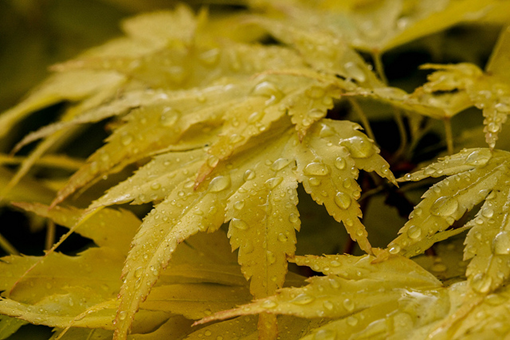
Plants are coated with a hydrophobic waxy covering known as a cuticle. Image credit: Adrian Scottow. Licensed under: CC BY-SA 2.0.
Biologists are from Venus, organic geochemists are from Mars
In the run up to the meeting, held 16–19 June 2015 in beautiful Ascona, Switzerland, I realized that the majority of speakers and delegates were organic geochemists, rather than plant scientists like myself. Other than brief discussions with the academics in the University of Bristol’s School of Chemistry I hadn’t had much interaction with this area of research, so didn’t really know what to expect.
Plant biologists are interested in cuticular waxes because of their impact on the physiology of the plant. The cuticle is composed of many different types of compounds, including alkanes, alcohols, aldehydes, ketones and esters, to say nothing of the more complicated compounds I learnt about at the conference (triterpenoids, anyone?). Each compound gives the wax certain characteristics, making it more suited to a particular environment, or to enhancing a particular function. Many of these changes, however, are yet to be fully understood.
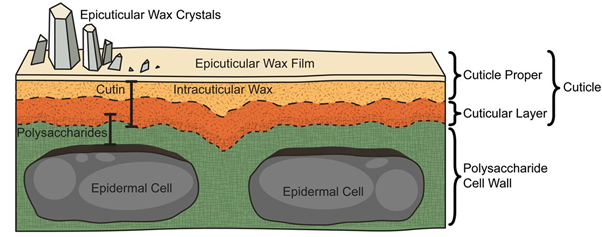
The cuticle is formed of hydrophobic wax compounds on a scaffold of cutin (a polyester polymer), topped with a layer comprising only wax. Image credit: Yeats and Rose, 2013. Plant Physiology.
Organic geochemists, on the other hand, extract plant waxes from soils, sediments and rocks and analyze them as an integrated signal to cleverly reconstruct past climates. They typically investigate n-alkanes, the simplest straight-chain compounds found in waxes, which are least likely to break down over time. Amazingly, they can look at the ratio of deuterium (heavy hydrogen, 2H) to normal hydrogen (1H) in the n-alkanes to work out the plants’ source of water, or the ratio of 13C to 12C to work out whether the majority of plants at that time were using C3 or C4 photosynthesis.
The Plant Wax conference was organized to try and bring these two very different groups together, encouraging communication and crossover between research fields, and specifically, to answer the question: what could we learn from each other?
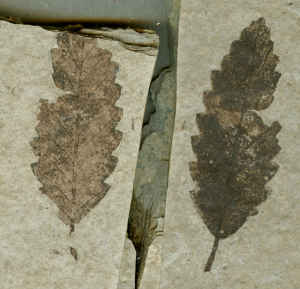
Plant waxes can be preserved in fossils, but organic geochemists typically look at sediments and sedimentary rocks. Image credit: James St. John. Licensed under CC BY 2.0.
At the start of the conference, I don’t think the majority of biologists had much knowledge of the finer details of organic geochemistry. Likewise, many geochemists said they only had a general overview understanding of wax biosynthesis and plant physiology. The two fields have very little crossover in the scientific literature.
Since geologists’ isotope studies are based on generalizations made from modern biological studies in a few plant species, the geologists had several requests for biologists. Firstly, to improve climate reconstructions, they asked for more biological data!
The geochemists asked the biologists whether there was anything they could help us with. It was quite hard for me to imagine how their methods – environmental reconstructions of the past based on biological studies – could help us with modern plant biology.
In fact, I felt a little smug. I’d been feeling decidedly ignorant while hearing about ingenious geochemistry research, so I almost felt vindicated: did they need us more than we needed them?
It wasn’t until the last day of the conference that I realized just how wrong I was.
One of the last talks was by Dr Nikolai Pedentchouk, University of East Anglia, UK. He’s a collaborator of Amelia Frizell-Armitage, my fellow Global Plant Council New Media Fellow, and works on wheat waxes from an organic geochemist’s perspective.
Nikolai described his research into carbon and hydrogen isotopes in the waxy compounds of glaucous (dull blue-ish grey wax) versus non-glaucous (glossy green) wheat: “I used a field set-up to investigate several issues that are of interest to palaeoecologists and palaeoclimatologists and potentially to plant biochemists. We really wanted to know whether differences in leaf wax composition or amount resulted in differences in the isotope values of individual compound classes”.
How could this isotope research be useful to biologists? Amazingly, it could be used to elucidate the biosynthetic pathways for the different compounds in wheat wax – something that has so far not been possible using standard biological techniques.
“When plants synthesize organic compounds they fractionate stable isotopes, for example 13C vs. 12C and 2H vs. 1H. By measuring the isotopic composition of individual compound classes we could potentially reconstruct the order of reactions that could have led to the biosynthesis of a particular compound”, explained Nikolai.
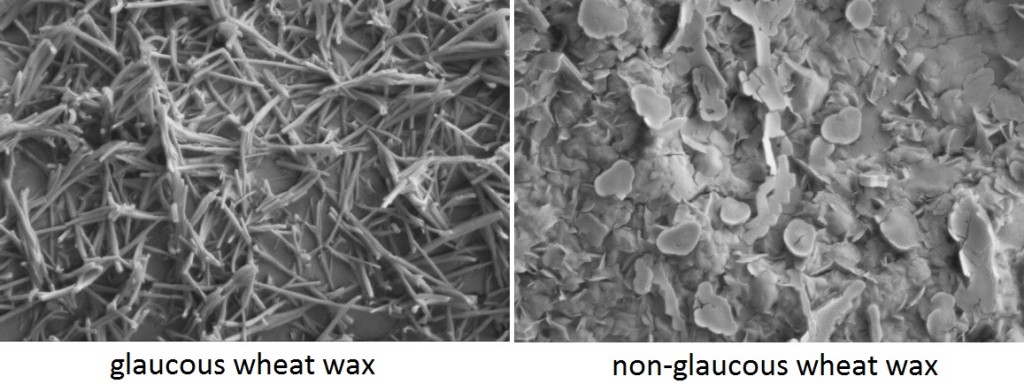
Wax crystals of glaucous (dull blue-ish grey) and non-glaucous (glossy) wheat wax crystals, taken on a scanning electron microscope. Image credit: Amelia Frizell-Armitage.
Nikolai’s application of geochemical techniques to solve a biological problem really opened my eyes to the innovations that can be made when people from vastly different research backgrounds work together and share ideas. Whether its using quantum mechanics to improve our understanding of photosynthesis, or chemical and computational modeling to advance synthetic biology, interdisciplinary collaboration is driving plant science research forwards, and I encourage you all to think outside your research box too!
The fifth report of the International Panel on Climate Change (IPCC) published last year announced that climate change is already negatively affecting our food supply and this problem is only going to be amplified in coming decades.
Our climate is projected to warm by 5ºC by 2050, with increased incidence of extreme weather events. Coinciding with this is a rapidly rising global population, predicted to reach 9.6 billion by 2050. Feeding all these extra mouths is challenge enough. Doing this under changing weather and climate conditions becomes even more difficult.
Food shortages resulting from population growth or unusual weather events can lead to rising food prices and political instability. A global rice shortage in 2008 saw prices rise by over 50%, resulting in riots in Asia and Africa. We might expect events such as this to become more common in the future as the food supply becomes more and more affected by climate change.
Not surprisingly food security is currently a buzz word in the research community, and many resources are being poured into trying to ensure a stable food supply for future generations.
Some climate skeptics argue that increases in carbon dioxide could boost plant growth, resulting in higher yielding plants under climate change. However, the reality is that any positive effect the increased CO2 could have on plant growth is likely to be outweighed by higher temperatures and extreme weather events.
Since the IPCC report there have been a number of studies focussed on the staple food crop wheat, and how yields could be affected in the future.
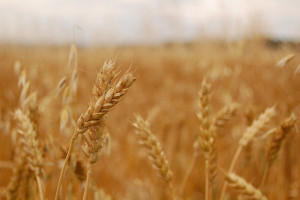
Wheat was first domesticated 10,000 years ago and is now grown more widely than any other crop. Photo by jayneandd used under CC BY 2.0.
Wheat yields are sensitive to temperature, and are predicted to fall by around 6% for every 1ºC rise in temperature. If we do not cut down current emissions, the earth could warm by 5ºC by 2050, equating to a 30% reduction in wheat yields due to temperature increases alone.
This 30% reduction in yield is only the tip of the iceberg. Yields could be further reduced by increased instances of disease epidemics. For example, Fusarium Ear Blight is a wheat disease that causes spikelet bleaching and enhanced senescence. A severe epidemic can wipe out 60% of a wheat crop. In order to take effect, the disease requires wet weather at flowering, something which we can expect to happen more often in the future according to climate models.
Extreme weather events, such as flooding, are predicted to increase over the coming decades, and will cause unavoidable crop losses. This will exacerbate problems with declining yields, further increasing the difficulty of feeding a growing population.
What can we do?
Primarily, we should be trying to limit the extent of climate change, and to do so we need to act now. Reducing emissions and moving to sustainable energy sources should be at the top of the agenda. However, most climate scientists agree that even if we act now to reduce our emissions, there will be at least 2ºC of warming, which is already impacting on food production.
We therefore need to make our food sources more resilient to climate change. In terms of wheat this means breeding varieties that are tolerant to higher temperatures and diseases. Additionally, we will need to adapt our farming methods, to be more intensive yet sustainable, and perhaps alter our diets.
Stress Resilience Forum, 23–25 October, Iguassu Falls, Brazil
In October the Global Plant Council, in collaboration with the Society of Experimental Biology, will bring together experts from around the world to discuss current research efforts in plant stress resilience. Abstract submission and registration for the Stress Resilience Forum is now open, and we welcome researchers at all levels to take part.
The meeting takes place immediately before the International Plant Molecular Biology Conference (25–30 October), also at Iguassu Falls, and which also includes several scientific sessions on plant stresses.